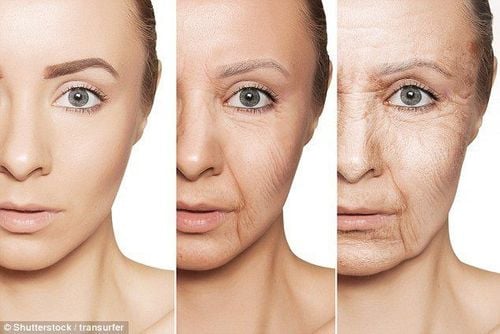This is an automatically translated article.
The article was professionally consulted with Specialist Doctor II Le Thanh Cam - Pediatrician - Pediatrics - Neonatology - Vinmec Danang International General Hospital.Hutchinson-Gilford premature aging syndrome is an extremely rare, progressive genetic disorder that causes children to age prematurely, starting as early as the second year of life. Heart problems or stroke are the leading cause of death in most children with geriatrics, shortening life expectancy many times over.
1. What is Hutchinson-Gilford Premature Aging Syndrome?
Hutchinson-Gilford premature aging syndrome, also known as progeria, is a rare genetic condition that is fatal in early childhood with the hallmarks of premature aging.Children with presbyopia are usually normal in appearance during infancy, but by about 9 to 24 months of age, children will begin to experience marked growth retardation, resulting in short stature and low birth weight.
At the same time, these children also develop a distinct face shape, characterized by a disproportionately small face relative to the head; underdeveloped jaw, deformed and crowded teeth; abnormal eye exposure; Small nose and small mouth. By the second year of life, hair on the scalp, eyebrows, and eyelashes is heavily shed, which can be replaced by small hairs like fluff, white or blonde.
In addition, children also suffer from other diseases such as atherosclerosis, degenerative cardiovascular disease and stroke, hip dislocation, scalp veins, loss of subcutaneous fat, making the skin wrinkled), defects nail defects, stiffness, and bone deformities.
These conditions lead to life-threatening complications during childhood, adolescence, or early adulthood. As a result, children with Hutchinson-Gilford premature aging syndrome will die of atherosclerotic heart disease at an average age of 13 years. As with any adult with heart disease, events common as heart disease progresses for children with geriatrics can also include hypertension, stroke, angina, and heart failure. All of these conditions are considered to be related to aging.
The cause of Hutchinson-Gilford premature aging syndrome has so far been found to be due to a mutation in the LMNA gene, also known as lamin A. The lamin A protein, which plays a role in connecting the nucleus of cells together. Researchers now believe that a defect in the lamin A protein makes the cell nucleus unstable. Cell instability appears to lead to premature senescence in geriatrics.

2. Symptoms of Hutchinson-Gilford syndrome of premature aging
Usually during the first year of life, the growth of a child with geriatrics seems to slow down markedly while the child's motor and intellectual development remains as normal.Signs and symptoms of this progressive disorder are described including:
Retardation in height growth Below average weight Narrow face, small lower jaw, thin lips, and protruding nose Disproportionately large head Face Embossed eyes and incompletely closed eyelids Hair loss, loss of eyelashes and eyebrows Thin skin, freckles, and wrinkles Visible veins High-pitched voices In addition, children with aging syndrome Early Hutchinson-Gilford also had manifestations of diseases caused by aging such as:
Progressive cardiovascular disease Dull, thick and hard skin (similar to scleroderma) Slow teething Deafness Hearing Loss of lower fat layer Skin Muscle atrophy Bone deformity, thin and fragile bones Stiff joints Hip dislocation Insulin resistance
3. How is Hutchinson-Gilford premature aging syndrome diagnosed?
Doctors may suspect geriatrics based on the characteristic signs and symptoms of Hutchinson-Gilford syndrome. Then, a genetic test for LMNA mutations can confirm this diagnosis.A complete physical examination of a child suspected of having presbyopia includes:
Measurement of height and weight Growth curve charting Hearing and vision testing Measuring physiological signs vital, including blood pressure Look for typical visible signs and symptoms on the body such as head, face, eyes, nose, skin, bones.

4. Is Hutchinson-Gilford premature aging syndrome treatable?
To date, researchers have not found a cure for Hutchinson-Gilford premature aging syndrome. However, because atherosclerotic diseases are the leading cause of death, regular monitoring of heart, brain and blood vessel disease can help control the child's health.During medical visits, the child's weight and height should be measured and plotted on a growth chart. In addition, other routine evaluations, including electrocardiograms and dental, vision, and hearing exams, may also be recommended by the physician for prompt intervention or supportive measures.
Some therapies have been shown to reduce or delay some of the signs and symptoms of Hutchinson-Gilford premature aging syndrome. However, the specific treatment depends on the condition and symptoms of each child. These therapies may include:
Low-dose Aspirin : Daily dose can help prevent heart attacks and strokes. Statins : Lower cholesterol , improve atherosclerosis Blood pressure lowering drugs Physical therapy and movement : These therapies can help with stiffness problems to help children maintain normal functioning. Nutrition: Encourage children to eat small amounts with many meals a day. Nutritious, calorie-rich foods and fortified vitamins can help maintain adequate nutritional needs. Teeth care .

5. Living with Hutchinson-Gilford Premature Aging Syndrome
Because children with presbyopia often develop early and rapidly atherosclerotic cardiovascular disease, the causes of morbidity and mortality in children are:Coronary artery disease : ischemic heart disease , myocardial infarction leading to heart attacks and congestive heart failure Cerebrovascular disease leading to stroke Other health problems associated with aging such as arthritis, cataracts and increased risk of cancer Therefore, parents need to monitor and detect early signs of abnormalities in their children, to take them to the doctor for timely examination and treatment. In addition, in the process of taking care of children at home, the following should be noted:
Give the child enough water to drink. Dehydration can have more serious consequences in children with senility. Therefore, make sure your child drinks plenty of water, especially when sick, when active or when the weather is hot. Offer small and frequent meals. Since nutrition and body growth are a problem for these children, feeding them smaller and more frequent meals can help increase calorie intake. Add healthy foods and snacks as needed. Give your child the opportunity to get regular physical activity, and consult with your doctor to find out what activities are right for your child. Wear cushioned shoes or insoles for your child. The reduction of subcutaneous fat that occurs in the feet can be uncomfortable for a child. It is necessary to use sunscreen when children are outdoors to protect their skin. Complete immunization in childhood to ensure children's comprehensive health protection. Maintain normal social and academic opportunities for children. Since presbyopia does not affect children's intelligence, children can still attend school at an age-appropriate level. Adjust household items and furniture so that children can be independent and confident in school activities. personal activities. Hutchinson-Gilford premature aging syndrome is a rare genetic disease that causes premature death from degenerative diseases that manifest in the early years of life. Although there is no effective treatment yet, current care and proactive preventive therapies can help improve the child's prognosis to some extent, at least assuring the child's life years. equivalent to children of the same age.
Please dial HOTLINE for more information or register for an appointment HERE. Download MyVinmec app to make appointments faster and to manage your bookings easily.
Articles refer to sources: mayoclinic.org, rarediseases.org













